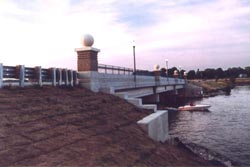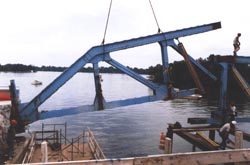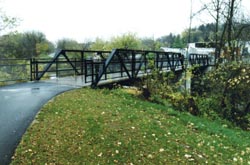Belleville Bridge: APWA Project of the Year, 1996
|
WHAT MAKES THE BELLEVILLE BRIDGE replacement so significant is not the level of impact it had on its community. Nor is it the size or scope of the project.
What makes the Belleville Bridge project so special is the effort that was given to the oft-forgotten side of engineering: Saving a great work from the past [in this case, to prepare for the new]. In going to such uncommon measures to preserve a small piece of history, those involved became part of an engineering odyssey that will surely have historic relevance years from now for the profession.
In short, the real significance of Wayne County's Belleville Bridge project is the cooperation, dedication and innovation needed to accomplish the seemingly simple feat of replacing an old bridge.
EARLY HISTORY
THE BELLEVILLE BRIDGE was built in 1925 by the Wayne County Road Commission to replace a smaller structure that spanned the Huron River. Today, the bridge spans part of the five-mile long Belleville Lake, which was created when a
river dam was built in 1925 as part of a Detroit Edison Hydroelectric plant.
Back then, the city of Belleville was a sparsely populated town about an hour-and a-half drive to downtown Detroit along Michigan Avenue. Today, it's a burgeoning city a stone's throw from Interstate 94, which will get you downtown in about 30 minutes.
|
It was also significant because, according to the State Historic Preservation Officer, the bridge "represents a relatively early use of riveted Warren truss construction that became the norm for pony truss structures in succeeding years."
In 1925, the bridge survived a scare when the earthen embankment abutting the dam broke and "gave way to a roar that could be heard for several miles," according to resident Dr. Samuel Robbe. While the young lake was completely drained in the event, the bridge itself sustained only minor damages.
RECENT HISTORY
IN 1985, WAYNE COUNTY engineers conducted traffic studies to determine what they already knew: The two-lane Belleville Bridge could no longer accommodate the traffic volumes being placed on it. Designed to handle up to 18,000
vehicles per day, it was often seeing 23,000. And the city was still growing.
In addition, inspections showed that while the metal truss structure was sound, the concrete abutments below the bridge were showing signs of weakening. The county sent a Critical Bridge application to the state for replacement funding.
In October of that year, the funds were approved and the county began sending out requests for design consultants. One of those who applied was Alan Halbeisen of W.W. Engineering & Science. While he would not get the job, he later would play a critical role in the project.
On January 15, 1986, Wayne County received a letter from the Deputy State Historic Preservation Officer. In it, she stated that the Belleville Bridge was potentially eligible for the National Register of Historic Places as an example of a riveted camelback pony truss. Removing the bridge would dilute its historical significance.
A week later, the county was informed by the state than an Environmental Assessment [EA] would be required before the project could proceed.
Already, this had the makings of a complicated project.
|
Wayne County's director of engineering, Ed Siemert, knew he had a dilemma. He was either going to have to tear down a structurally sound historic bridge, or, somehow, find it a new home.
After a great deal of consideration, and with no known precedent, he chose the latter. In doing so, he launched a public works juggling act that, despite its relatively small scale, would require more creativity, inter-governmental cooperation and seat-of-the-pants planning than any project he had been involved in during his 30-year career. Not to mention a decent sense of humor.
In fact, the project, which resulted in a unique three-way Michigan bridge trade, has been dubbed in the media a "case of musical bridges," "a bridge too far," and a "recycling program for historic bridges." It has even generated television stories, such as the one where the reporter peeks out from behind some bushes and whispers to the camera, "Psst. Hey buddy, wanna buy a bridge?"
Despite the novelty of the project, the replacing of the Belleville Bridge is certainly one of the most interesting and complex public works projects Wayne County has ever seen. It has involved one township, two cities, two counties, the State of Michigan and the FHWA. It also has involved three bridges in two regions of the state; one lake, two rivers, dozens of community meetings; a decade of planning; two years of construction and a lot of luck.
"If we had decided to scrap the old bridge, it would have been a lot easier," recalls Siemert, who has overseen the project from its beginning. "But it was a perfectly good bridge we had just outgrown.
-
"So, we decided to try and sell it."
"Psst. Hey buddy, wanna buy a bridge?"
Only he meant it. And this is where the story really begins.
|
INDEED, IN JULY OF 1989, the county took out classified ads. The county's sales pitch began with this straightforward heading "Bridge Available for Relocation."
In the Sunday Detroit News, the ad was placed next to other ones for AKC puppies. [As if someone reading the classifieds on that day who was thinking of purchasing a Labrador Retriever, would instead decide, "Naw, this bridge looks like a better deal."]
In addition to the Detroit News the county also took out ads in the Detroit Free Press and the Michigan Contractor & Builder. The county also sent letters to nine public agencies across the state, hoping for some interest.
To sweeten the pot, the county even offered to pay relocation fees up to the amount it would have cost to demolish the bridge [about $100,000]. But try as it might to peddle the metal structure, the county had no takers. Even a flourish of media stories produced no results.
There were, however, two semi-serious prospects: The City of Detroit was interested in putting the bridge in one of its parks over the Rouge River. And an airline pilot had a notion to move the bridge to his sprawling property in the State of Washington, or even to use it there as a public bridge.
Alas, neither of the prospects panned out and eventually the county decided it would have to scrap the historic structure.
'Maybe it just wasn't a realistic idea to sell, or even give away a bridge,' Siemert thought.
After all, it was hard enough trying to find someone who wanted a 70-year-old riveted camelback pony truss bridge. To make things more difficult, conditions the county had to abide by stated that if sold, the bridge had to be kept up in such a way as to maintain its historical significance and that it have adequate safety and capacity features to serve as a public bridge.
While the county abandoned its search for takers and requested approval from the state to demolish it, planning began for the new bridge. [Since the historic twist had stalled the project in 1988, the county had to again advertise for consultants.] Plans also included widening and reconstructing about a mile of Belleville Road, from I-94 to the bridge, which led directly to the city's vibrant downtown.
The project would be finished in one year, but would require the complete closure of the road during that time. "Wrong," said the members of the Belleville Central Business District. "We'll all go out of business if our major thoroughfare is closed for a year."
After several meetings, phone calls and letters between the county and city officials, merchants and residents, the county agreed to provide for the new bridge's construction to be phased over two years. It mean keeping the road open, but it also meant a two-year inconvenience instead of one. The city was willing.
Another hurdle had been jumped.
Then the rumblings began that since the road leading into town was being widened to four and five lanes and the bridge to four, the county surely would no longer allow two lanes of parking along Main Street, the four lane extension of Belleville Road through downtown. From an engineering standpoint, that made sense. But understanding the need for parking in a central business district, the county decided to keep both parking lanes available, despite the continued fear of merchants.
THE CONNECTION IS MADE
WHILE WAYNE COUNTY went about its business, Al Halbeisen, who had sought a contract on the Belleville Bridge project a year and a half earlier, was working with the City of Portland, Michigan, on a project called "Rails to Trails."
Portland was looking for a small bridge to be used for pedestrian traffic and recreation use over the Looking Glass River. He had hoped to find an existing one-lane structure that could be rehabbed and moved, or perhaps salvage one
that was being thrown away.
His search took him to nearby Lowell to the Burroughs Street Bridge over the Flat River. There, he found that, yes, not only did the Kent County Road Commission need to replace the bridge because it could no longer support vehicle traffic, but they were willing to give it to him.
There was, of course, the significant issue of a replacement.
About a week later something stuck in Halbeisen's mind when thinking about the Burroughs Street BSridge, sort of a sense of dejá vu. Then it hit him: Both the Burroughs Bridge and the Belleville Bridge were 120 feet in length.
The connection was made.
After taking a closer look at both bridges' specifications, and the needs of the respective communities, Halbeisen realized that everyone's needs could be met with only Wayne County having to construct a new bridge. The others could be saved.
"It was a fluke," said Halbeisen. "It's not like we go shopping these things around." That was, however, exactly what Wayne County had tried.
As luck would have it, the recently-enacted Intermodal Surface Transportation Efficiency Act [ISTEA] of 1991provided funds for historic preservation and for pedestrian transportation facilities. Kent County and Portland submitted their applications just prior to the October 15 deadline.
"We had been proceeding under the assumption we were going to have to demolish the old bridge," said Wayne County's Siemert. "Then, in the bottom of the ninth inning, this came along."
Another major hurdle had been cleared.
WORK GETS UNDER WAY
SINCE KENT COUNTY'S Burroughs Street Bridge had been closed to traffic for about six months, they were anxious to get their new one. But before Wayne County could start dismantling its old bridge, half of the new one had to be
constructed to keep traffic flowing, as per the agreement with downtown merchants.
The new structure would be a four-lane, three-span reinforced concrete highway bridge, which would not resemble the original. In order to provide a design that would be in harmony with the community, the design consultant hired a local graphic artist to do conceptual drawings.
|
The superstructure of the new bridge utilizes 45" deep precast, prestressed concrete I-beams. The beams were placed in each span and then made structurally continuous for live load. The main reason for continuity was the elimination of deck joints and deck drainage onto the structure. Continuity also improved the bridge's look and riding quality.
The substructure consists of conventional cantilevered abutments supported on steel H-piles and pier caps supported on cast-in-place concrete piles. The depth of the water made pile driving and construction difficult and required the use of cofferdams and tremie seals at the abutments.
Having learned a lesson from the original construction of the bridge in 1924, extra effort was paid to the earthwork of the causeways. After the original construction, a large section of pavement had to be replaced when it collapsed due to settling soil. Fortunately, perhaps thanks to the extra effort this time around, no such settling appears to be taking place on the causeways.
There were, of course, unexpected surprises.
In addition to the extra earth work, the original truss bridge contained a series of communications cables that served much of southwestern Wayne County. Since these cables could not be removed, they needed to be protected and constantly looked after throughout the two-year project. The project was completed with no damage to the cables and no interruptions in service.
DISMANTLING
|
During much of the process, floating pontoons were employed to provide support from a work platform in the lake.
Over the two weeks the bridge was dismantled, a bond was formed between the construction crew and local residents. Whenever somebody wanted a souvenir from the old bridge, they were given rivets that did not need to be saved.
And, as is often done when a structure is completed, crews placed an American flag, but again, things were in reverse. Instead of putting it atop the finished new bridge, it was placed on the bridge about to be dismantled. As each section was removed, the flag would be placed on the next section. The fact that this transpired around the Fourth of July holiday, made the gesture especially popular among residents.
By the time the bridge was dismantled and ready to ship to Grand Rapids for repainting, the Burroughs Street Bridge had been rehabbed and was in place in its new home over the Looking Glass River [top photo].
After about nine months of having to use detours, Kent County motorists finally were able to take Burroughs Street over the Flat River again in September, when the bridge that started the whole odyssey [middle photo] was reassembled.
Finally, and appropriately, at Christmas time, Belleville residents untied the ribbon on their new road and bridge [bottom], marking a new beginning.






 Once spanning the Flat River near Grand Rapids, Michigan, this historic bridge now traverses
the Looking Glass river in Portland, Michigan.
Once spanning the Flat River near Grand Rapids, Michigan, this historic bridge now traverses
the Looking Glass river in Portland, Michigan.  Look familiar?
Look familiar?